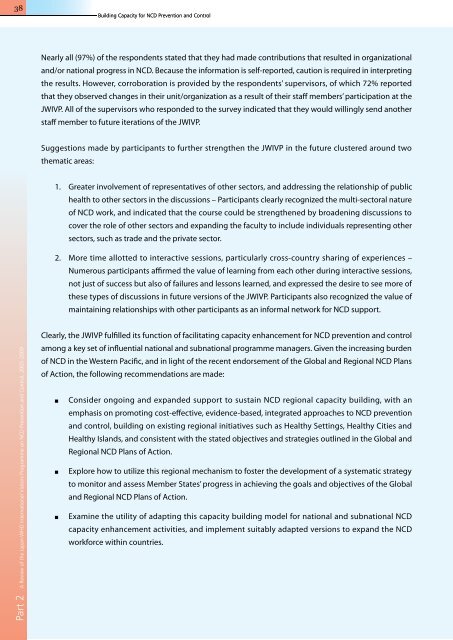Building capacity for NCD prevention and control meeting
Building capacity for NCD prevention and control meeting
Building capacity for NCD prevention and control meeting
Create successful ePaper yourself
Turn your PDF publications into a flip-book with our unique Google optimized e-Paper software.
38<br />
REPORT: A Review REGIONAL of the Japan-WHO MEETING International ON PREVENTION Visitors AND Programme CONTROL on OF <strong>NCD</strong> Prevention <strong>and</strong> Control, 2005-2009<br />
Part Part 12<br />
<strong>Building</strong> Capacity <strong>for</strong> <strong>NCD</strong> Prevention <strong>and</strong> Control<br />
Nearly all (97%) of the respondents stated that they had made contributions that resulted in organizational<br />
<strong>and</strong>/or national progress in <strong>NCD</strong>. Because the in<strong>for</strong>mation is self-reported, caution is required in interpreting<br />
the results. However, corroboration is provided by the respondents’ supervisors, of which 72% reported<br />
that they observed changes in their unit/organization as a result of their staff members’ participation at the<br />
JWIVP. All of the supervisors who responded to the survey indicated that they would willingly send another<br />
staff member to future iterations of the JWIVP.<br />
Suggestions made by participants to further strengthen the JWIVP in the future clustered around two<br />
thematic areas:<br />
1.<br />
2.<br />
Greater involvement of representatives of other sectors, <strong>and</strong> addressing the relationship of public<br />
health to other sectors in the discussions – Participants clearly recognized the multi-sectoral nature<br />
of <strong>NCD</strong> work, <strong>and</strong> indicated that the course could be strengthened by broadening discussions to<br />
cover the role of other sectors <strong>and</strong> exp<strong>and</strong>ing the faculty to include individuals representing other<br />
sectors, such as trade <strong>and</strong> the private sector.<br />
More time allotted to interactive sessions, particularly cross-country sharing of experiences –<br />
Numerous participants affi rmed the value of learning from each other during interactive sessions,<br />
not just of success but also of failures <strong>and</strong> lessons learned, <strong>and</strong> expressed the desire to see more of<br />
these types of discussions in future versions of the JWIVP. Participants also recognized the value of<br />
maintaining relationships with other participants as an in<strong>for</strong>mal network <strong>for</strong> <strong>NCD</strong> support.<br />
Clearly, the JWIVP fulfi lled its function of facilitating <strong>capacity</strong> enhancement <strong>for</strong> <strong>NCD</strong> <strong>prevention</strong> <strong>and</strong> <strong>control</strong><br />
among a key set of influential national <strong>and</strong> subnational programme managers. Given the increasing burden<br />
of <strong>NCD</strong> in the Western Pacifi c, <strong>and</strong> in light of the recent endorsement of the Global <strong>and</strong> Regional <strong>NCD</strong> Plans<br />
of Action, the following recommendations are made:<br />
n<br />
n<br />
n<br />
Consider ongoing <strong>and</strong> exp<strong>and</strong>ed support to sustain <strong>NCD</strong> regional <strong>capacity</strong> building, with an<br />
emphasis on promoting cost-eff ective, evidence-based, integrated approaches to <strong>NCD</strong> <strong>prevention</strong><br />
<strong>and</strong> <strong>control</strong>, building on existing regional initiatives such as Healthy Settings, Healthy Cities <strong>and</strong><br />
Healthy Isl<strong>and</strong>s, <strong>and</strong> consistent with the stated objectives <strong>and</strong> strategies outlined in the Global <strong>and</strong><br />
Regional <strong>NCD</strong> Plans of Action.<br />
Explore how to utilize this regional mechanism to foster the development of a systematic strategy<br />
to monitor <strong>and</strong> assess Member States’ progress in achieving the goals <strong>and</strong> objectives of the Global<br />
<strong>and</strong> Regional <strong>NCD</strong> Plans of Action.<br />
Examine the utility of adapting this <strong>capacity</strong> building model <strong>for</strong> national <strong>and</strong> subnational <strong>NCD</strong><br />
<strong>capacity</strong> enhancement activities, <strong>and</strong> implement suitably adapted versions to exp<strong>and</strong> the <strong>NCD</strong><br />
work<strong>for</strong>ce within countries.

















